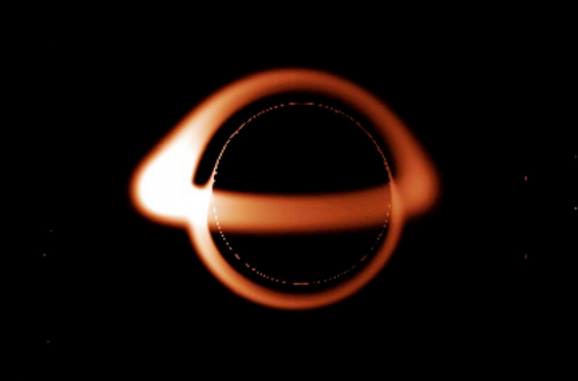Loop quantum gravity theory offers glimpse beyond the event horizon

In principle, nothing that enters a black hole can leave the black hole. This has considerably complicated the study of these mysterious bodies, which generations of physicists have debated since 1916, when their existence was hypothesized as a direct consequence of Einstein's Theory of Relativity. There is, however, some consensus in the scientific community regarding black hole entropy—a measure of the inner disorder of a physical system—because its absence would violate the second law of thermodynamics. In particular, Jacob Bekenstein and Stephen Hawking have suggested that the entropy of a black hole is proportional to its area, rather than its volume, as would be more intuitive. This assumption also gives rise to the "holography" hypothesis of black holes, which (very roughly) suggests that what appears to be three-dimensional might, in fact, be an image projected onto a distant two-dimensional cosmic horizon, just like a hologram, which, despite being a two-dimensional image, appears to be three-dimensional.
As we cannot see beyond the event horizon (the outer boundary of the back hole), the internal microstates that define its entropy are inaccessible. So how is it possible to calculate this measure? The theoretical approach adopted by Hawking and Bekenstein is semiclassical (a sort of hybrid between classical physics and quantum mechanics) and introduces the possibility (or necessity) of adopting a quantum gravity approach in these studies in order to obtain a more fundamental comprehension of the physics of black holes.
Planck's length is the (tiny) dimension at which space-time stops being continuous as we see it, and takes on a discrete graininess made up of quanta, the "atoms" of space-time. The universe at this dimension is described by quantum mechanics. Quantum gravity is the field of enquiry that investigates gravity in the framework of quantum mechanics. Gravity has been very well described within classical physics, but it is unclear how it behaves at the Planck scale.
Daniele Pranzetti and colleagues, in a new study published in Physical Review Letters, present an important result obtained by applying a second quantization formulation of loop quantum gravity (LQG) formalism. LQG is a theoretical approach within the problem of quantum gravity, and group field theory is the "language" through which the theory is applied in this work.
"The idea at the basis of our study is that homogenous classical geometries emerge from a condensate of quanta of space introduced in LQG in order to describe quantum geometries," explains Pranzetti. "Thus, we obtained a description of black hole quantum states, suitable also to describe 'continuum' physics—that is, the physics of space-time as we know it."
Condensates, quantum fluids and the universe as a hologram
A "condensate" in this case is a collection of space quanta, all of which share the same properties so that even though there are huge numbers of them, we can nonetheless study their collective behavior by referring to the microscopic properties of the individual particle. So now, the analogy with classical thermodynamics seems clearer—just as fluids at our scale appear as continuous materials despite consisting of a huge number of atoms, similarly, in quantum gravity, the fundamental constituent atoms of space form a sort of fluid—that is, continuous space-time. A continuous and homogenous geometry (like that of a spherically symmetric black hole) can, as Pranzetti and colleagues suggest, be described as a condensate, which facilitates the underlying mathematical calculations, keeping in account an a priori infinite number of degrees of freedom .
"We were therefore able to use a more complete and richer model compared with those done in the past in LQG, and obtain a far more realistic and robust result," says Pranzetti. "This allowed us to resolve several ambiguities afflicting previous calculations due to the comparison of these simplified LQG models with the results of semiclassical analysis as carried out by Hawking and Bekenstein". Another important aspect of Pranzetti and colleagues' study is that it proposes a concrete mechanism in support to the holographic hypothesis, whereby the three-dimensionality of black holes could be merely apparent: all their information could be contained on a two-dimensional surface, without having to investigate the structure of the inside (hence the link between entropy and surface area rather than volume).
More information: Daniele Oriti et al, Horizon Entropy from Quantum Gravity Condensates, Physical Review Letters (2016). DOI: 10.1103/PhysRevLett.116.211301
Journal information: Physical Review Letters
Provided by International School of Advanced Studies (SISSA)



















